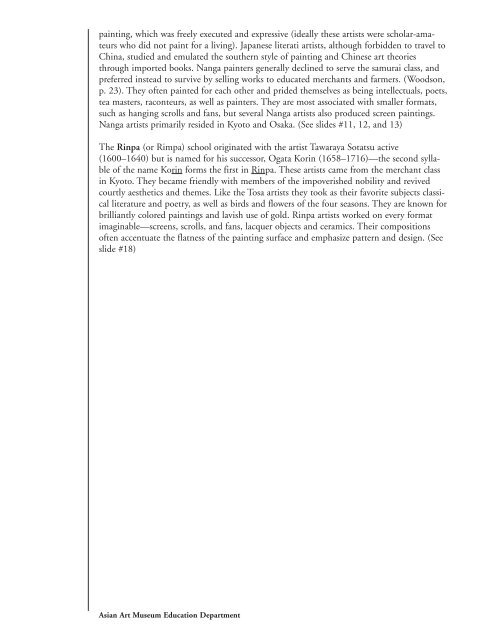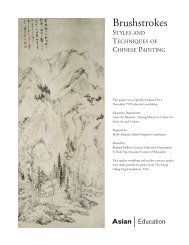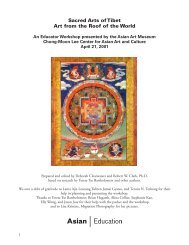Download PDF - Asian Art Museum | Education
Download PDF - Asian Art Museum | Education
Download PDF - Asian Art Museum | Education
Create successful ePaper yourself
Turn your PDF publications into a flip-book with our unique Google optimized e-Paper software.
painting, which was freely executed and expressive (ideally these artists were scholar-amateurs<br />
who did not paint for a living). Japanese literati artists, although forbidden to travel to<br />
China, studied and emulated the southern style of painting and Chinese art theories<br />
through imported books. Nanga painters generally declined to serve the samurai class, and<br />
preferred instead to survive by selling works to educated merchants and farmers. (Woodson,<br />
p. 23). They often painted for each other and prided themselves as being intellectuals, poets,<br />
tea masters, raconteurs, as well as painters. They are most associated with smaller formats,<br />
such as hanging scrolls and fans, but several Nanga artists also produced screen paintings.<br />
Nanga artists primarily resided in Kyoto and Osaka. (See slides #11, 12, and 13)<br />
The Rinpa (or Rimpa) school originated with the artist Tawaraya Sotatsu active<br />
(1600–1640) but is named for his successor, Ogata Korin (1658–1716)—the second syllable<br />
of the name Korin forms the first in Rinpa. These artists came from the merchant class<br />
in Kyoto. They became friendly with members of the impoverished nobility and revived<br />
courtly aesthetics and themes. Like the Tosa artists they took as their favorite subjects classical<br />
literature and poetry, as well as birds and flowers of the four seasons. They are known for<br />
brilliantly colored paintings and lavish use of gold. Rinpa artists worked on every format<br />
imaginable—screens, scrolls, and fans, lacquer objects and ceramics. Their compositions<br />
often accentuate the flatness of the painting surface and emphasize pattern and design. (See<br />
slide #18)<br />
<strong>Asian</strong> <strong>Art</strong> <strong>Museum</strong> <strong>Education</strong> Department
















